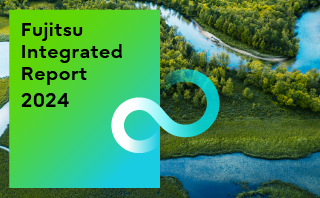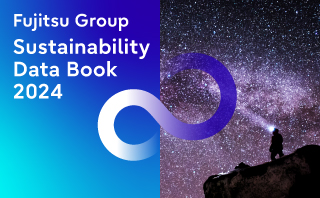-
Sustainability at Fujitsu Group
- Sustainability Management in the Fujitsu Group
- GRB(Global Responsible Business)Goals and Achievments for FY2022
- GRB(Global Responsible Business)Goals for FY2025
- Fujitsu's accessibility
- Stakeholder Engagement
- United Nations Global Compact
- SDG-related Activities in Fujitsu
- External Recognition and Awards
-
Global Responsible Business
- Environment
-
- Environmental Management
- The Fujitsu Group Environmental Vision on Climate Change
- Living in Harmony with Nature (Conservation of Biodiversity)
- Environmental Action Plan
- Environmental Data
- Environmental Communication
- Environmental Social Activities
- Disposal and Recycling of ICT products
- Environmental Considerations in ICT Products
- Governance
-
Data and Documents
- Fujitsu Group Sustainability Data Book 2024
- Social, Governance and Environmental data
- Independent Assurance Report

- GRI Standards / United Nations Global Compact (UNGC) principles Comparison Table
- SASB Standards Comparison Table
- Sustainability Information Disclosure Framework
- Link to regions responsible business reports
- Contact
- Sitemap
Resource Circulation
External Trends
Strengthening Global Resource Circulation
Goal 12 of the Sustainable Development Goals (SDGs), adopted by the United Nations in September 2015, is ‘Responsible consumption and production’. The actions that organizations are urged to take in order to meet this goal include the efficient use of natural resources, the appropriate management of chemical substances and waste products throughout the entire product life cycle, and significant reductions in the volume of pollutants emitted into the air, water, and soil. The European Commission also announced its Sustainable Products Initiative (SPI), the cornerstone of its new Circular Economy Action Plan (CEAP), in March 2020. It launched a series of bills and policy packages central to achieving the objectives of the CEAP, including the Eco-Design for Sustainable Products Regulation (ESPR). The ESPR product scope not only expanded, but the Regulation also established performance requirements such as recyclability, durability, repairability, and use of recycled materials. With the increase in product sustainability requirements, the ESPR will also introduce a Digital Product Passport (DPP) to trace throughout the product life cycle, and Carbon Footprint to provide environmental impact assessment information. The requirement for more efficient use of resources is expected to increase worldwide. For example, in the U.S., more and more states are passing Right to Repair laws, while in Japan, the Ministry of Economy, Trade and Industry (METI) is working on building a Circular Economy Information Distribution Platform. Companies will need to accommodate these requirements going forward.
The Problem of Plastic Waste
A report published by the Organization for Economic Cooperation and Development (OECD) in June 2022 predicts that the amount of plastic waste generated globally will triple by 2060 from its 2019 level of 353 Mt. Additionally, while the resumed session of the Fifth United Nations Environment Assembly (UNEA-5.2) held in February 2022 recognized the usefulness of plastics, it also noted that the problem of plastic pollution, in particular marine pollution, is global in scale. It therefore convened an intergovernmental negotiating committee to begin work during the second half of 2022 on developing an international legally binding instrument on plastic pollution, including in the marine environment, with the ambition of concluding the instrument by the end of 2024. In view of these developments, companies need to engage in plastic resource circulation throughout the product life cycle.
The Fujitsu Group’s Position
Aiming for Resource Circulation
The Fujitsu Group has a long-standing commitment to the 3Rs of resource management: reduce, reuse, recycle. The push of the "Circular economy" is gaining momentum worldwide. In particular, the abovementioned CEAP adopted in Europe in March 2020 has prompted a wave of discussion around resource recycling, including such topics as the reuse of waste as a resource, improvement of product recyclability and the use of recycled materials. Our existing practices already incorporate recycled plastics in ICT products and use paper instead of plastic for packaging. Building on this foundation, we are now taking a step further by promoting measures such as reducing the number of parts in our products and making them smaller, thinner, and lighter. We are also focusing on the reuse of resources from used ICT products and waste generated at our business sites. In the past, reusing resources from used ICT products continues to be one of the targets of our Environmental Action Plan. We have achieved a reuse rate of over 90% for ICT products used in business and are committed to maintaining this high level and are now continuing our efforts as internal target. In light of the urgent need to address the problem of plastic waste, as outlined above, we will continue to implement initiatives that target packaging materials and other plastic waste. Although changes in our business structure have led to a reduction in overall waste generated, we remain dedicated to further reducing waste and strengthening our recycling and resource utilization efforts to further contribute to a more recycling oriented society.
In addition to company-wide measures such as resource-conserving products, we will look at circular economy business models tailored to the characteristics of individual products, and place greater emphasis on designing products tailored to these new business models.
Responses to The Act on Promotion of Resource Circulation for Plastics
Given the growing environmental challenges posed by plastic waste, both in Japan and globally, there is a need for immediate measures to promote plastic resource recycling, including rationalizing their use, municipal recycling, and establishing systems to encourage voluntary collection and recycling by businesses.
Designated a “high-volume waste emitter” under the legislation, Fujitsu has established targets for reducing and recycling plastic waste and is implementing activities in line with those targets.
Target: Promotion of zero-emissions activities for plastic waste and greater use of returnable plastics
FY2023 waste plastics emissions: 1.8 thousand tons
RELATED INFORMATION
Actions and targets related to resource circulation initiatives under the Fujitsu Group Environmental Action Plan (Stage XI)


